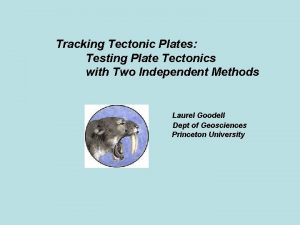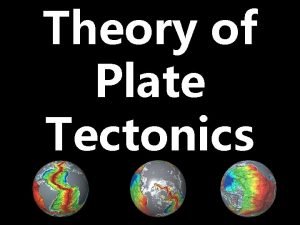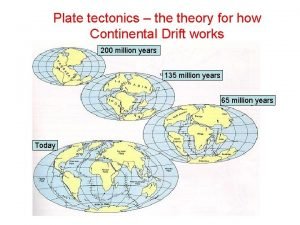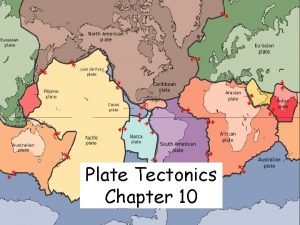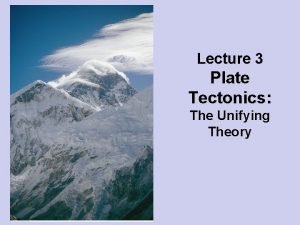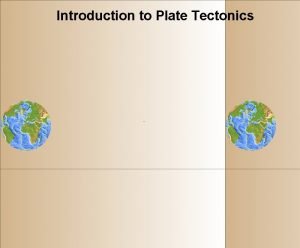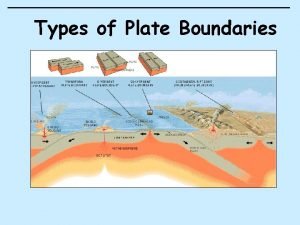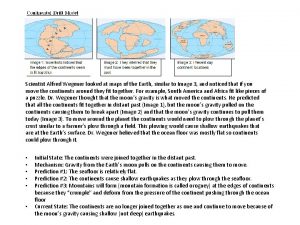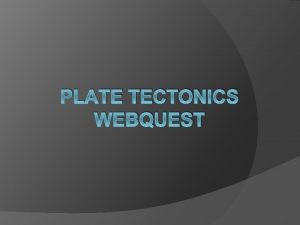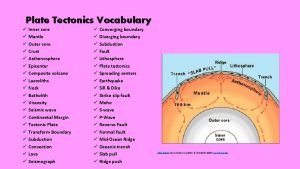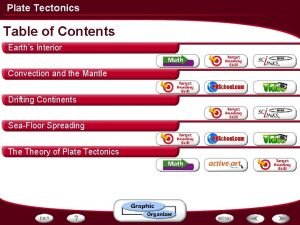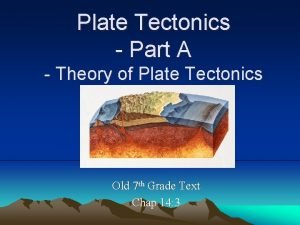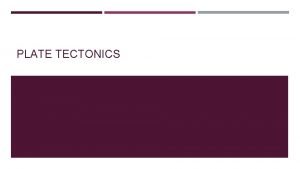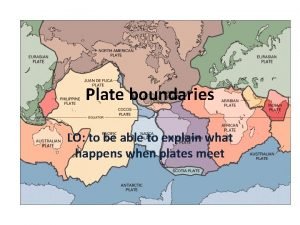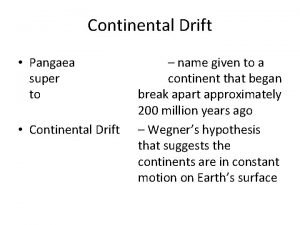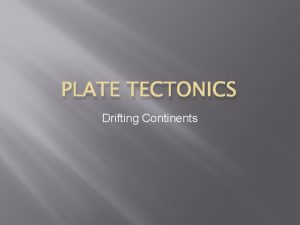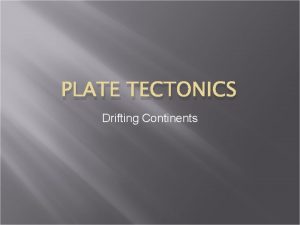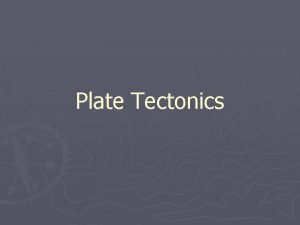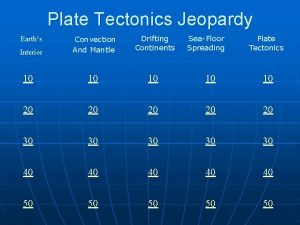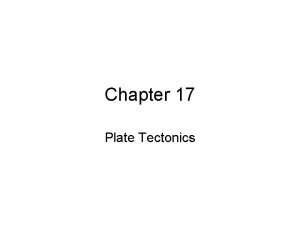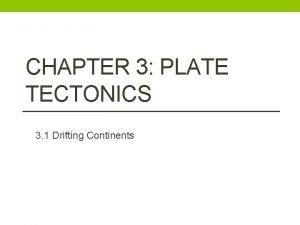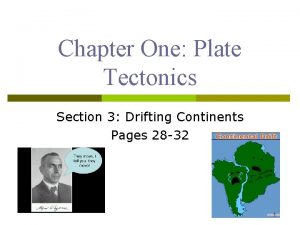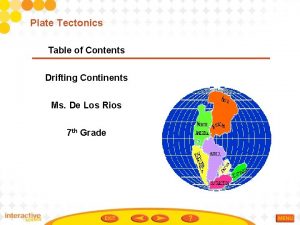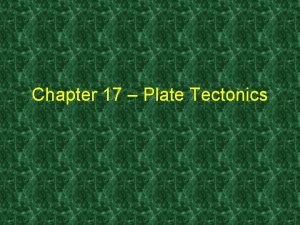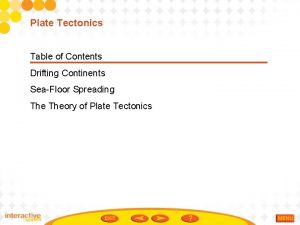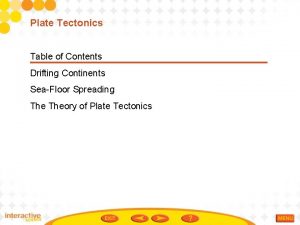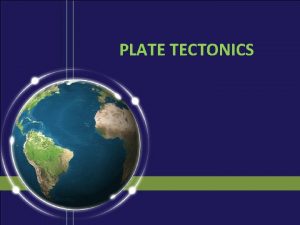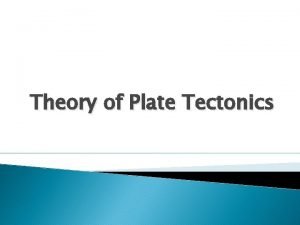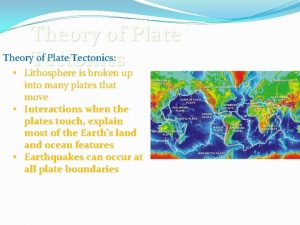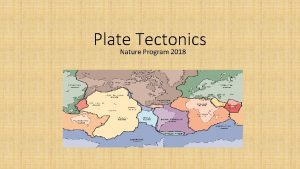Plate Tectonics Earths Drifting Continents The theory of






















- Slides: 22

Plate Tectonics

Earth’s Drifting Continents The theory of continental drift, stated by Wegner, a German meteorologist, says that Earth once had a single landmass that broke up into pieces, which have since drifted apart. Scientists call this giant landmass, Pangaea, which means all Earth.

Evidence from Fossils Evidence from identical fossils found in both South America and Africa supports Wegner’s theory. Fossils of Glossopteris, an extinct plant, found in rocks from South Africa, Australia, India and Antarctica provide support. The seeds of this plant were too large to have been carried by the wind and too fragile to have survived the ocean waves.

Antarctica The presence of Glossopteris fossils in the frozen wasteland of Antarctica also indicate that the climate must have changed greatly. Antarctica must have changed position.

Evidence from Rock An ancient folded mountain chain formed in Africa lines up with matching folded mountains in South America. Coal field layers found in Brazil line up with coal field layers in Africa. Glacial deposits found in areas of warm climate also provide evidence. Salt deposits normally formed between 35 and 10 degrees North and South of the equator are found as far north as Michigan.

Earth’s Spreading Ocean Floor Scientists discovered a large system of underwater mountains that have a deep crack, called a rift valley, running through their center, known as the midocean ridges. A great deal of volcanic activity occurs at the midocean ridges. Lava erupts from the rift valley. The hardened lava forms new ocean floor. This process is known as oceanfloor spreading.

Transform Faults Ocean-floor spreading helps to explain how continents drift. As a piece of the ocean floor moves, it takes its continent (if it has one) with it. Individual sections of midocean ridges are straight but the ridges as a whole curve. This is because the straight sections are offset by thin cracks known as transform faults. The youngest rock is near the midocean ridge. As the floor spreads, older rocks move farther away from the ridge.

Magnetic Stripes A permanent record of the Earth’s magnetism remains in the rocks. Scientist discovered that the Earth’s magnetic poles reverse themselves from time to time. Studies show that during the past 3. 5 million years, the magnetic poles have reversed themselves nine times. The pattern is identical on both sides of the midocean

Subduction As the older ocean floor moves away from the midocean ridges, it will eventually move down deep into the Earth along the trenches. When the rocks are pushed deep enough, they are melted by the heat of the Earth. Some of it will rise up through the crust and produce volcanoes but most of the molten rock will become part of the mantle.

Earth’s Moving Plates The word plate refers to the moving, irregularly shaped slab that fit together like paving stones to form the surface of the Earth. The word tectonics refers to the branch of geology that deals with the movements that shape the Earth’s crust. The theory of plate tectonics links continental drift and ocean-floor spreading to explain the formation, collisions, movements and destructions of the Earth’s crust.

Lithospheric Plates The topmost solid part of the Earth, called the lithosphere, is made of a number of plates. The plates contain a thin layer of crust above a thick layer of relatively cool, rigid mantle rock. Plates usually contain both oceanic and continental crust. There are seven major lithospheric plates, each of which is named after its

Seven Lithospheric Plates The Pacific plate covers 1/5 of the Earth’s surface. The other major plates are the North American, South American, Eurasian, African, Indo-Australian and Antarctic plates. There also smaller plates such as the Caribbean and Arabian plates.

Plate Boundaries Plates move at different speeds and in different directions. Smaller landmasses move more slowly. In a few cases, the edges of the continents are the boundaries of plates. Most plate boundaries are on the ocean floor.

Types of Plate Boundaries There are three types of plate boundaries. Convergent Divergent Strike-Slip Boundaries

Divergent Boundaries The first type occurs at midocean ridges. Because the plates move apart, the ridges are called divergent. These boundaries are also called constructive boundaries.

Convergent Boundaries The second type of plate boundary has trenches. Because the plates come together at the trenches, the trenches are called convergent. They are also called destructive. The collision of plates at convergent boundaries causes tremendous friction and pressure. Earthquakes often result. This explains why the Ring of Fire follows the major ocean trenches in that area.

Strike-Slip Boundaries The third type of plate boundary is formed by a lateral fault. Boundaries formed by lateral boundaries are called strikeslip boundaries. At a strike-slip boundary, two plates grind together and slip past each other horizontally. No new plate material is destroyed or made. Earthquakes often occur along strike-slip boundaries, such as the San Andreas Fault.

Plate Motion Scientists are not sure exactly what makes the plates move. One hypothesis is that large convection currents within the Earth move the plates. A convection current is the movement of material caused by differences in temperature. Mantle material close to the core is very hot. Mantle material farther from the core is cooler and less dense. Rising and sinking of magma occurs in a circular

Collision of Oceanic/Continental Plates Oceanic plates are more dense than continental plates. When an oceanic plate collides with a continental plate, the continental plate rides over th edge of the oceanic plate. The subduction of the oceanic plate pushes up and folds the continental crust on the edge of the continental plate and forms mountain ranges such as the Andes of South America.

Oceanic Plate Collision When two oceanic plates collide, the older oceanic plate is subducted under the younger. (Plates grow denser as they cool. )The plate being subducted melts. Molten rock then rises up and breaks through the surface. As a result, a string of volcanoes erupts on the ocean floor along the trench. Sometimes they may rise above the ocean’s surface as a string of islands, such as Japan and the Aleutian Islands.

Collision of Continental Plates When two continental plates collide, the edges of the continents fold upward to form large mountain ranges, such as the Appalachian Mountains. They were formed when Africa collided with North America during the formation of Pangaea. In some cases they have same density and the edges of the continents thicken and are pushed upward to form ranges like the Himalayas.

Possible Changes in Plates Any change in one plate or boundary affects all the other plates and boundaries. There are many changes that can occur in plates and their boundaries. Continental plates may fuse together. A trench may switch direction and begin to subduct a formerly overriding plate. New divergent boundaries may form in the center of continents. Plates may also be completely subducted and disappear.
 Compare continental drift and plate tectonics
Compare continental drift and plate tectonics Plate tectonics vs continental drift
Plate tectonics vs continental drift Evidence of the theory of plate tectonics
Evidence of the theory of plate tectonics The plate tectonics theory states that
The plate tectonics theory states that Rodinia
Rodinia Summarize the theory of plate tectonics
Summarize the theory of plate tectonics Explain the theory of plate tectonics.
Explain the theory of plate tectonics. Types of plate boundaries
Types of plate boundaries Theory of plate tectonics
Theory of plate tectonics Plate tectonics vs continental drift
Plate tectonics vs continental drift Types of plate tectonics
Types of plate tectonics Compare continental drift and plate tectonics
Compare continental drift and plate tectonics Continental drift webquest
Continental drift webquest Plate tectonics vocabulary worksheet
Plate tectonics vocabulary worksheet Mantle convection and plate tectonics
Mantle convection and plate tectonics Plate tectonics definition
Plate tectonics definition Driving force of plate tectonics
Driving force of plate tectonics Concept map plate tectonics
Concept map plate tectonics Harry hess and seafloor spreading
Harry hess and seafloor spreading Plate tectonics test review answer key
Plate tectonics test review answer key Plate boundaries
Plate boundaries Oreo cookies and plate tectonics
Oreo cookies and plate tectonics A plate tectonics puzzle worksheet answer key
A plate tectonics puzzle worksheet answer key


